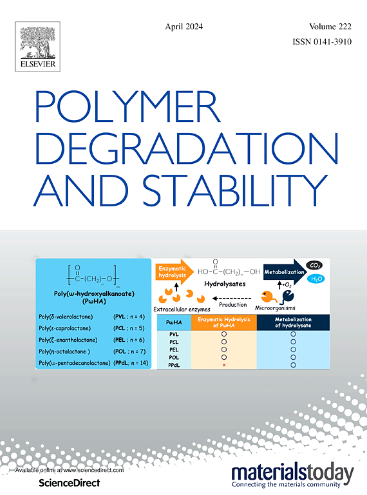利用磷的氧化态设计高效含磷阻燃剂的新策略及其在环氧树脂中的性能
IF 6.3
2区 化学
Q1 POLYMER SCIENCE
引用次数: 0
摘要
磷的氧化态对其阻燃剂的阻燃作用有很大影响。本研究合成了一种具有低磷和高磷两种氧化态的活性含磷阻燃剂(POG-DOPO),并将其加入环氧树脂中。结果表明,高氧化态部分主要在凝聚相中起作用,低氧化态部分主要在气相中起作用。此外,该阻燃剂还具有协同阻燃效果,与单一磷氧化态的阻燃剂相比,其阻燃效率更高。与未改性环氧树脂相比,仅含 3wt% 磷的 POG-DOPO 改性环氧树脂的峰值热释放率、总热释放率和总烟释放率分别降低了 70.9%、51.2% 和 55.7%。其 LOI 增加到 31.8%,垂直燃烧测试达到了 UL-94 V-0 等级。这项研究为高效磷基阻燃剂的结构设计提供了一种策略。本文章由计算机程序翻译,如有差异,请以英文原文为准。
A novel strategy utilizing oxidation states of phosphorus for designing efficient phosphorus-containing flame retardants and its performance in epoxy resins
The oxidation state of phosphorus has a great influence on the flame retardant action of its flame retardants. In this study, a reactive phosphorus-containing flame retardant (POG-DOPO) with both low and high phosphorus oxidation states is synthesised and incorporated into epoxy resin. The results show that the part in high oxidation state act mainly in the condensed phase and the part in low oxidation state act mainly in the gas phase. Furthermore, the flame retardant exhibits a synergistic flame retardant effect, resulting in a higher flame retardant efficiency than that of flame retardants with a single phosphorus oxidation state. Compared with unmodified epoxy resin, the peak heat release rate, total heat release rate and total smoke release of POG-DOPO modified epoxy resin with only 3wt% phosphorus are reduced by 70.9%, 51.2% and 55.7%, respectively. Its LOI increases to 31.8% and vertical combustion test achieves UL-94 V-0 rating. This study provides a strategy for the structural design of efficient phosphorus-based flame retardants.
求助全文
通过发布文献求助,成功后即可免费获取论文全文。
去求助
来源期刊

Polymer Degradation and Stability
化学-高分子科学
CiteScore
10.10
自引率
10.20%
发文量
325
审稿时长
23 days
期刊介绍:
Polymer Degradation and Stability deals with the degradation reactions and their control which are a major preoccupation of practitioners of the many and diverse aspects of modern polymer technology.
Deteriorative reactions occur during processing, when polymers are subjected to heat, oxygen and mechanical stress, and during the useful life of the materials when oxygen and sunlight are the most important degradative agencies. In more specialised applications, degradation may be induced by high energy radiation, ozone, atmospheric pollutants, mechanical stress, biological action, hydrolysis and many other influences. The mechanisms of these reactions and stabilisation processes must be understood if the technology and application of polymers are to continue to advance. The reporting of investigations of this kind is therefore a major function of this journal.
However there are also new developments in polymer technology in which degradation processes find positive applications. For example, photodegradable plastics are now available, the recycling of polymeric products will become increasingly important, degradation and combustion studies are involved in the definition of the fire hazards which are associated with polymeric materials and the microelectronics industry is vitally dependent upon polymer degradation in the manufacture of its circuitry. Polymer properties may also be improved by processes like curing and grafting, the chemistry of which can be closely related to that which causes physical deterioration in other circumstances.
 求助内容:
求助内容: 应助结果提醒方式:
应助结果提醒方式:


